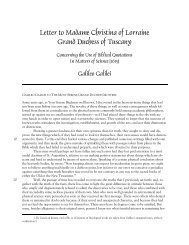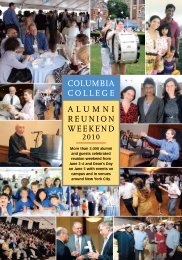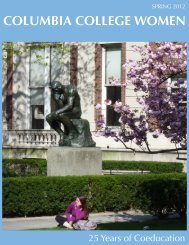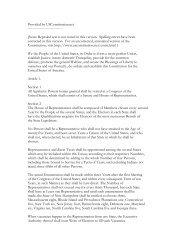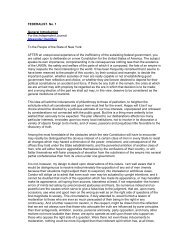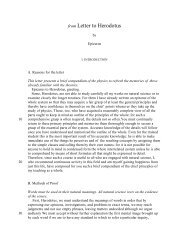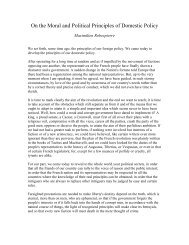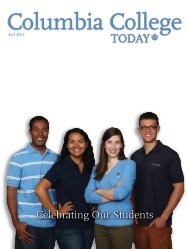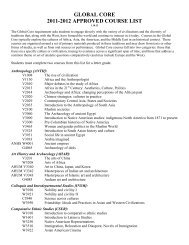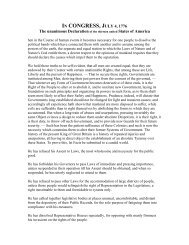Download this issue as a PDF - Columbia College - Columbia ...
Download this issue as a PDF - Columbia College - Columbia ...
Download this issue as a PDF - Columbia College - Columbia ...
Create successful ePaper yourself
Turn your PDF publications into a flip-book with our unique Google optimized e-Paper software.
FACULTY FIND LIT HUM CHALLENGING, FULFILLING<br />
COLUMBIA COLLEGE TODAY<br />
COLUMBIA COLLEGE TODAY<br />
In addition to the required work, professors<br />
can add one or more texts of their<br />
own choosing. Popular selections include<br />
Toni Morrison’s Beloved, Ralph Ellison’s Invisible<br />
Man and Anthony Burgess’ A Clockwork<br />
Orange. Ladenson adds Margaret Atwood’s<br />
The Penelopiad — the story of the<br />
Trojan War from Penelope’s point of view<br />
— to the Fall syllabus, following The Odyssey.<br />
In the Spring, she <strong>as</strong>ks the cl<strong>as</strong>s to vote<br />
on an additional text. “They suggest things<br />
like One Hundred Years of Solitude; I propose<br />
things like A Portrait of the Artist <strong>as</strong> a Young<br />
Man,” she says. “When we narrow it down,<br />
every single time they’ve voted for Lolita.<br />
It’s a surefire hit, and it alludes to the entire<br />
tradition we’ve read.”<br />
Stalnaker doesn’t <strong>as</strong>sign additional reading<br />
and instead gives her charges breathing<br />
room to read and absorb the required texts.<br />
She says there’s an ongoing concern among<br />
faculty about whether the students can and<br />
do read all of the works versus skim, skip or rely on SparkNotes,<br />
and “whether the ambition of the syllabus inspires superficial<br />
reading. My experience is that the v<strong>as</strong>t majority of them do read<br />
and get a lot out of the experience.”<br />
Ladenson h<strong>as</strong> discovered the same: “It’s a huge amount of<br />
reading — it’s <strong>as</strong>tonishing anyone does it all — but I’ve been impressed<br />
by how many students do most or all of the reading and<br />
come to cl<strong>as</strong>s prepared,” she says. “And even if they don’t, it’s<br />
good for them to be exposed to it.”<br />
The reading list always h<strong>as</strong> been daunting, for nearly any student,<br />
but Williams thinks today’s students are challenged more<br />
than ever due to technology. “The act of reading is not what it<br />
w<strong>as</strong> 20 years ago. The Internet is a technological marvel in so<br />
many ways but it perhaps h<strong>as</strong> had considerable consequences<br />
for traditional reading practices,” he says. “These books presuppose<br />
a thoughtfulness about life and self-reflection, which are<br />
challenged by the speed of information retrieval in the Internet<br />
age. The students are <strong>as</strong> bright and committed <strong>as</strong> they ever were<br />
but now are used to instant access to information and a sense of<br />
speed. Books are slow burners. The character development and<br />
time frames are much slower than what the students are often<br />
used to, and that requires a recalibration.”<br />
The first-year students are largely divided between those who<br />
can’t wait to delve into the venerated Core courses, starting with<br />
Lit Hum — for many, the Core is what attracted them to the <strong>College</strong><br />
in the first place — and those who possess little innate interest<br />
in what they initially see <strong>as</strong> dusty, irrelevant or just plain hardto-get-through<br />
books. “Sometimes you get somebody horrified<br />
Anne Holt, a first-year graduate preceptor,<br />
takes notes at one of the weekly Lit Hum<br />
staff meetings.<br />
PHOTO: BRUCE GILBERT<br />
by the Core, who says, ‘I’m a science guy’<br />
or whatnot, and then they find they love<br />
it,” Ladenson says. “That’s a very gratifying<br />
pedagogic experience.”<br />
Students are known to contact their professors<br />
after the course — sometimes weeks<br />
later, sometimes years — to tell them how<br />
much Lit Hum meant to them and the impact<br />
it h<strong>as</strong> had on their lives. Cavallo cites a<br />
student who returned to his home country<br />
of India and started a vocational training<br />
company he named after Athena. “It really<br />
touches me when students are inspired in<br />
their life choices by Lit Hum,” she says.<br />
Not everyone is so converted of course.<br />
Some students don’t complete all the readings<br />
or participate actively in the discussions.<br />
“Not all of them care or pay attention<br />
or have a good time,” Ladenson says. “With<br />
Lit Hum, <strong>as</strong> with everything, what you get<br />
out of it reflects what you put into it.”<br />
Cavallo says the romantic ideal of students<br />
debating the books in dining halls and residence halls turns<br />
out to be true. She w<strong>as</strong>n’t sure until her two children came to the<br />
<strong>College</strong> and reported the phenomenon first-hand, which she w<strong>as</strong><br />
grateful to hear.<br />
Students are known to contact their professors<br />
weeks, even years, after the course to<br />
tell them how much it meant to them.<br />
Although the course is billed <strong>as</strong> life-changing for students, faculty<br />
often get <strong>as</strong> much out of teaching it <strong>as</strong> the students do taking it.<br />
Intimacy with the texts informs the professors’ research and writing<br />
in their own fields and enriches their personal lives <strong>as</strong> well.<br />
When Hurricane Sandy flooded much of Cavallo’s home in Toms<br />
River, N.J., in October, she spent the night on the kitchen counter<br />
watching the tidal surge reach the windowsills and reflecting on<br />
Herodotus. “I w<strong>as</strong> thinking of how Solon warned Croesus that you<br />
never know what’s going to happen in life,” she says. “It w<strong>as</strong> a<br />
confirmation of the wisdom that can be found in ancient texts.”<br />
“If I could teach one course forever, it’d be Lit Hum,” Rosen<br />
says. “But Lit Hum wants you to move on and do other things<br />
and come back to it, and each time you do, the books are different,<br />
the students are different, you’re different.”<br />
Ladenson, too, enjoys being pushed out of her comfort zone<br />
and, in fact, values the experience of teaching Lit Hum so much<br />
that she’s considering expanding her horizons. “I’m toying with<br />
taking CC — oh, that’s a huge slip! — I meant teaching CC, or Art<br />
Hum. It’ll be a stretch for me, which is why I want to do it.”<br />
Shira Boss ’93, ’97J, ’98 SIPA is contributing writer to CCT. Her l<strong>as</strong>t<br />
feature w<strong>as</strong> a profile of filmmaker, faculty member and Center for the<br />
Study of Ethnicity and Race Director Frances Negrón-Muntaner in the<br />
Winter 2012–13 <strong>issue</strong>.<br />
Selig obliged. Among the books were a trio by Mann (Confessions<br />
of Felix Krull, Confidence Man; Death in Venice; and Doctor<br />
Faustus) and two each by Flaubert (Sentimental Education;<br />
Madame Bovary) and Joyce (Dubliners; A Portrait of the Artist <strong>as</strong> a<br />
Young Man). He also advised the short stories of de Maup<strong>as</strong>sant,<br />
Faulkner’s The Sound and the Fury and Forster’s A P<strong>as</strong>sage to India;<br />
Defoe’s Robinson Crusoe and Crane’s The Red<br />
Badge of Courage; and García Márquez’s One<br />
Hundred Years of Solitude. All told, there were<br />
about 30 titles.<br />
In 2010, Callan visited Selig a second time,<br />
<strong>this</strong> time at an <strong>as</strong>sisted living center on the<br />
Upper West Side, to tell him he had finished<br />
the list and to <strong>as</strong>k for more recommendations.<br />
“Read them again,” said Selig.<br />
Lit Hum for Life<br />
“I left <strong>Columbia</strong> with an understanding of<br />
the power of <strong>as</strong>king the right questions.”<br />
B y A l e x i s T o n t i ’11 A r t s<br />
On the day after his college graduation, the l<strong>as</strong>t thing Chuck Callan ’78<br />
did before leaving Morningside w<strong>as</strong> visit Professor Karl-Ludwig Selig<br />
at his office in Hamilton Hall to <strong>as</strong>k for a reading list. “I did not want the<br />
power and ple<strong>as</strong>ure of the Core to end,” recalls Callan, who majored in<br />
economics. “Literature Humanities w<strong>as</strong> transformative for me.”<br />
“Literature Humanities w<strong>as</strong> transformative<br />
for me,” says Chuck Callan ’78.<br />
PHOTO: CHRIS BALMER ’07<br />
It is fair to say that, in 75 years, no student<br />
h<strong>as</strong> left Literature Humanities untouched<br />
by the experience. Some are relieved to<br />
have made it through — and no looking<br />
back, thank you very much. Others come<br />
away with a sense of satisfaction, and the confidence<br />
that the course h<strong>as</strong> in some essential<br />
way contributed to their becoming educated,<br />
well-rounded individuals. And many, many<br />
more experience Lit Hum <strong>as</strong> a kind of opening<br />
out: It incre<strong>as</strong>es their appetite for reading and broadens their<br />
other interests, attunes them to an ongoing and long-l<strong>as</strong>ting conversation<br />
about the world and equips them with new ways of<br />
engaging with others and with themselves.<br />
“The Core is about great, enduring truths that neither I nor, I<br />
dare say, humanity, can live without,” Callan says. (His literary<br />
adviser, Selig, died on December 1, 2012. See<br />
Around the Quads.)<br />
“Before taking the course I thought the<br />
subject matter of many of the books would<br />
never apply to me because of the differences<br />
in times,” says Dana Mondesire ’14. “On the<br />
contrary, by the end of each cl<strong>as</strong>s I w<strong>as</strong> thinking<br />
about the questions posed in the works<br />
and how they may have applied to my own<br />
life; I found that the themes we discussed in<br />
cl<strong>as</strong>s were just so relatable.”<br />
“It led to reevaluations of my own worldview.<br />
How much of what I believed w<strong>as</strong> simply<br />
the result of our cultural tradition” says<br />
Michael Carter ’14. “Paradoxically, by examining<br />
the conventional, Western tradition, I<br />
became much more open to alternate ways<br />
of thinking. Everybody always tells you that<br />
college is a place to ‘find yourself,’ to develop<br />
your opinions, to understand who you are.<br />
SPRING 2013<br />
26<br />
SPRING 2013<br />
27




